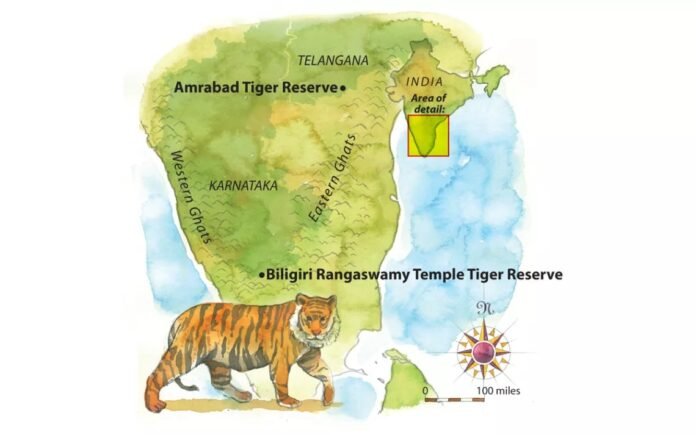
The Soliga tribe has long inhabited the Biligiri Rangaswamy Temple (BRT) Tiger Reserve in Karnataka, playing a crucial role in tiger conservation. Their harmonious relationship with the wildlife, particularly tigers, has significantly contributed to conservation efforts. Prime Minister Narendra Modi highlighted their contributions during the 119th edition of Mann Ki Baat, attributing the steady increase in tiger numbers to the Soligas’ traditional practices and cultural reverence for nature.
The Soliga Tribe: Guardians of the Forest
The name “Soliga” translates to “children of bamboo.” This indigenous community resides near the Biligiri Rangana Hills and Male Mahadeshwara Hills and has a deep-rooted connection with the forest.
- They were the first tribe in India to be granted official rights to live inside a tiger reserve (Biligiri Rangaswamy Temple Tiger Reserve).
- As of 2011, there were 33,871 Soligas in Karnataka and 5,965 in Tamil Nadu.
- The Soligas communicate in Sholaga (a Dravidian language), Kannada, and Tamil.
- They practice shifting cultivation and rely on forest produce for sustenance, with honey being a significant part of their diet.
Cultural Practices and Wildlife Conservation
The Soligas worship tigers, referring to them as Dodda Nayi (Big Dog) and even maintaining a temple dedicated to them. Their deep cultural respect for tigers has fostered a natural form of conservation, where coexistence with wildlife is integral to their way of life.
Their sustainable lifestyle ensures the preservation of natural habitats, making them model conservationists. By avoiding over-extraction and leaving portions of their harvest for the wildlife, they actively promote ecological balance.
Mitigating Human-Animal Conflict
Unlike other areas, human-animal conflict in the BRT Tiger Reserve is relatively low. The Soligas’ knowledge of animal behavior allows them to avoid encounters with tigers. By recognizing the signs of wildlife movement and adapting their routines accordingly, they minimize conflicts and protect both humans and animals.
Collaboration with the Forest Department
The Forest Department works closely with the Soligas, recognizing their deep knowledge of the land. The tribe actively participates in forest management, particularly in fire prevention efforts and wildlife monitoring. Their involvement has helped develop effective conservation strategies.
Fluctuating Tiger Population in BRT Tiger Reserve
The tiger population in BRT Tiger Reserve has seen notable changes over the years:
- 2014: 69 tigers
- 2018: 86 tigers
- 2022: Decline observed due to human interference and habitat degradation
Understanding these factors is crucial for future conservation measures. Addressing habitat destruction and ensuring that conservation efforts align with traditional tribal practices can help sustain the tiger population.
Recognizing Tribal Rights for Sustainable Conservation
In 2011, the Soligas became the first tribal community in India to have their forest rights officially recognized within a tiger reserve. This landmark ruling acknowledged their historical connection to the land and reinforced their role in conservation. Recognizing and empowering tribal rights can significantly enhance conservation efforts, ensuring sustainable and community-driven forest protection.
A Broader Perspective on Conservation
India’s diverse ecosystems thrive due to the deep-rooted relationship between tribal communities and wildlife. The Soligas’ example serves as a model for conservation. The Prime Minister also cited other cultural practices across India that support biodiversity, such as Karnataka’s Huli Vesha dance, further emphasizing the deep bond between tradition and environmental stewardship.
As conservation strategies evolve, integrating indigenous knowledge with modern approaches remains a key to preserving India’s wildlife and fostering sustainable ecosystems.

